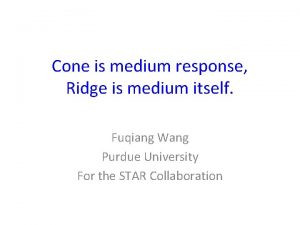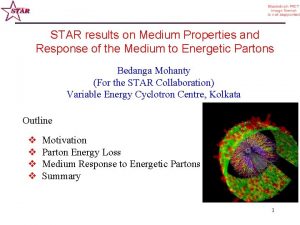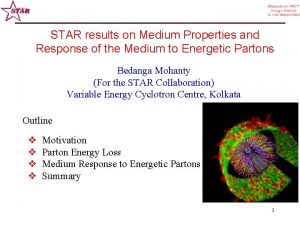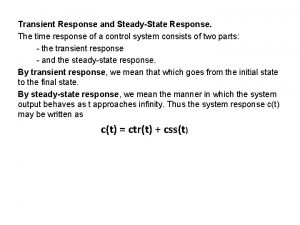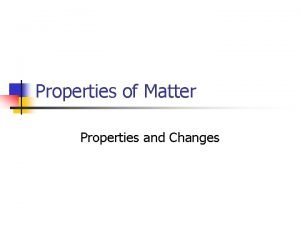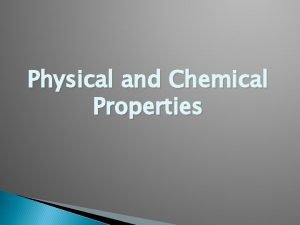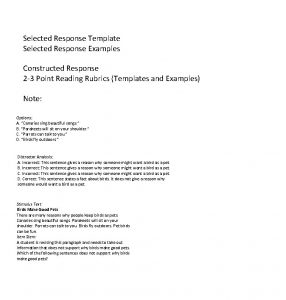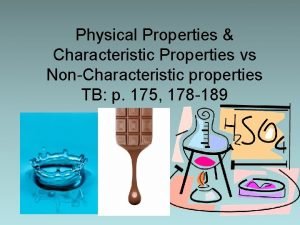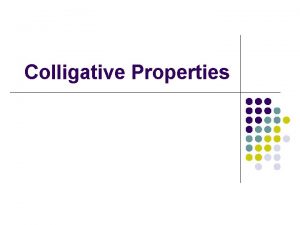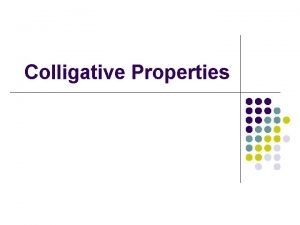Medium properties and response of the medium to


































- Slides: 34

Medium properties and response of the medium to highly energetic partons Bedanga Mohanty (For the STAR Collaboration) Variable Energy Cyclotron Centre, Kolkata Outline v v Motivation Parton Energy Loss Medium Response to Energetic Partons Summary 1

Motivation Medium Properties Physical phenomenon Experimental probes Energy Density Parton Eloss in the medium high p. T particle production, and correlations Velocity of sound Mach cones 3 -particle correlations Partonic interactions Mechanism of Eloss Non-Abelian features of QCD Color factor effects, path length effects of Eloss Jet-medium coupling High p. T particle production and correlations, correlations with respect to reaction plane Collectivity and Thermalization Partonic collectivity, viscosity and interactions Azimuthal anisotropy Medium effect on particle production mechanism Parton Recombination, modified/vacuum fragmentation Identified particle correlations Correlations play a significant role in understanding medium properties 2

Basic approach Calibrated probe Look for modification Medium formed in Heavy-ion collisions Near side j Leading/trigger particle Associated particles Absence of medium STAR : PRL 97 (2006) 252001 STAR : PLB 637 (2006) 161 Away side Jet and high p. T particle production in pp understood in p. QCD framework near Is there any modification in Heavy Ion Collisions ? away 3

Advantage of di-hadron correlations Single y (fm) Di-hadron y (fm) x (fm) Less surface bias Limited sensitivity of RAA to P( E, E) T. Renk, PRC 74 (2006) 034906 x (fm) H. Zhong et al. , PRL 97 (2006) 252001 Di-hadron correlations more robust probes of initial density ~ 1. 6 - 2. 1 Ge. V/fm 4

Current Observations in STAR High p. T suppression Parton Eloss Away side yield modification p. Tlp : 4 - 6 Ge. V/c STAR : PLB 655 (2007) 104 STAR : PRL 97 (2006) 152301 STAR : PRL 91 (2003) 072304 p. Tasoc : 2 Ge. V/c - p. Tlp Away side shape modification Enhanced correlated yield at large on near side d+Au, 40 -100% Medium Response STAR : J. Putschke, QM 2006 STAR : M. J. Horner, QM 2006 Reappearance of di-jets What does these features reveal about the medium ? STAR : PRL 97 (2006) 162301 5

Do they give answers to … Mechanism of energy loss in medium Few hard interactions or multiple soft interactions ? What is the Path length dependence of energy loss ? - L 2 or L Do we see a Color charge dependence of energy loss ? What is the probability distribution of parton energy loss ? Do partons loose energy continuously or discretely? Where does the energy from the absorbed jets go or how are they distributed in the medium? - Shock waves in recoil direction - Coupling of radiation to collective flow 6

Results on Partonic Eloss Parton Eloss Medium response Reappearance of di-jets Results to be discussed in this talk : System size dependence of Eloss : Dihadron Fragmentation functions Oana Catu (Parallel talk on 8 th Feb) Path length effects on parton Eloss : Di-hadron correlations with respect to reaction plane Aoqi Feng (Parallel Talk on 5 th Feb) Is there a difference in quark and gluon Eloss ? 7 Zhangbu Xu (Plenary Talk on 5 th Feb)

Di-hadron Fragmentation Function z. T=p. Tassoc/p. Ttrig 6< p. T trig < 10 Ge. V STAR Preliminary Au+Au 0 -12% H. Zhong et al. , PRL 97 (2006) 252001 ü Inconsistent with PQM calculations ü Modified fragmentation model better ü Denser medium in central Au+Au üDense medium formed in Au+Au collisions compared to Cu+Cu ü z. T distributions similar for Au+Au and Cu+Cu for similar Npart with energy loss parameter ~ 1. 6 -2. 1 Ge. V/fm 8 Oana Catu, Parallel Talk, 8 th February

Di-hadron correlations w. r. t Reaction Plane trigger in-plane S=0 3< p. Ttrig < 4 Ge. V/c, out-of-plane S=90 o p. Tasso : 1. 0 - 1. 5 Ge. V/c 20 -60% STAR Preliminary trigger out-of-plane Au+Au 200 Ge. V top 5% STAR Preliminary Observations : ü 20 -60% : away-side : from single-peak (φS =0) to double-peak (φS =90 o) ü Top 5% : double peak show up at a smaller φS ü At large φS, little difference between two centrality bins Aoqi Feng, Parallel Talk, 5 th February 9

Path Length Effects STAR Preliminary Au+Au 200 Ge. V 3< p. Ttrig < 4 Ge. V/c 1. 0 < p. Tasso < 1. 5 Ge. V/c At small φS ~ 0 (in-plane): similar to d. Au in 20 -60%. broader than d. Au in top 5%. At large φS ~ 90 o (out-of-plane): trigger in-plane trigger out-of-plane not much difference between the two centrality bins. away-side features reveal path length effects Aoqi Feng, Parallel Talk, 5 th February 10

Color Factors and q, g Eloss QCD : For SU(3) : Nc = 3 CA = 3 (gluons), CF = 4/3 (quarks) S = 0. 119 SU(3) is the gauge group for QCD i, j represent fermion field indices and a, b gauge field indices 2 ^ L E as C <q> Eg Eq An opportunity to relate experimental observable (of Eloss) to basic ingredient of QCD - Gauge Group through Color Factors ~ 9/4 11

Is there a difference in q, g Eloss Anti-particle to particle ratio Baryon & meson NMF Eg Eq ~ 9/4 Anti-Baryon to meson ratio Color factor effects not observed in pion, (anti-)proton ratios and Rcp upto p. T ~ 10 Ge. V/c 12 STAR : PLB 637 (2006) 161 STAR : PRL 97 (2006) 152301 STAR : PLB 655 (2007) 104

Future studies in STAR for color charge effect With Full TOF sketch With HFT N. Armesto et al. , PRD 71 (2005) 05427 Similar idea can also applied for R ( /h) B. Mohanty (for STAR) nucl-ex/0705. 9053 With LHC 13

Results on Medium Response Parton Eloss Medium response Reappearance of di-jets Results to be discussed in this talk : Conical Emission : Final 3 -particle results with higher p. T trigger, PID correlations Jason Ulery (Plenary Talk on 8 th Feb), Gang Wang (Parallel Talk on 8 th Feb, Guoliang Ma (Poster), Jiaxu Zuo (Poster), Quan Wang (Poster) Ridge in heavy ion collisions : Identified particle correlations, 3 -particle correlations Correlations w. r. t RP Pawan Netrakanti (Plenary Talk on 5 th Feb), Christine Nattrass (Parallel Talk on 8 th Feb), Jiaxu Zuo (Poster), Cristina Suraze (Poster), Betty Abelev (Poster) , Navneet Kumar (Poster) 14

Conical Emission vs Deflected Jets near Medium away deflected jets near Medium away Conical Emission Conical emission or deflected jets ? Associated p. T dependence of Cone angle distinguishes different conical emission scenarios Cone angle reflects time integrated speed of sound in the medium 15

3 -particle Correlations d. Au STAR Preliminary Central Au+Au 0 -12% Experimental evidence of Conical emission ( 1+ 2)/2 ( 1 - 2)/2 Central Au+Au 0 -12% STAR Preliminary ( 1+ 2)/2 Jason Ulery - Plenary Talk on 8 th February ( 1 - 2)/2 16

Mach-cone or Cerenkov Gluons STAR Preliminary ü Mach-cone: angle independent of associated p. T ü Cerenkov gluon radiation: decreasing angle with associated p. T Although p. T dependence hints at Mach-cone picture, observed cone angle ~ 1. 4 radians leads to very small (time averaged) velocity of sound in the medium 17

Conical Emission: Species dependence - Different particles possibly decouple at different times - Does Conical emission effect particle ratios - Does the correlation shape vary with particle mass (like in flow) | |<1. 0 protons central | |<1. 0 3<pt-trig<6 Ge. V/c 0. 15<pt_asso<0. 5 Ge. V/c STAR Preliminary Electron-hadron peripheral 18

Ridge in Heavy Ion Collisions d+Au, 40 -100% Au+Au, 0 -5% 3 < p. T(trig) < 6 Ge. V 2 < p. T(assoc) < p. T(trig) What does these features reveal about the medium ? Perhaps tells us how the energy lost by partons are distributed in the medium 19

Features of the Ridge (at QM 2006) STAR Preliminary Yield at large Independent on STAR Preliminary Ridge persists up to high p. T-trig TRidge ~ Tinclusive < Tjet Indication of two contributions Jet contribution + contribution arising due to jet Propagating in the medium What could be the different physics possibilities ? 20

Different physics possibilities Coupling of induced radiation to longitudinal flow N. Armesto et. al Phys. Rev. Lett. 93(2007) 242301 Turbulent color fields Anisotropic Plasma Jet quenching and radial flow A. Majumder et. al Phys. Rev. Lett. 99(2004)042301 S. A. Voloshin, Phys. Lett. B. 632(2007)490 E. Shuryak, hep-ph: 0706. 3531 Recombination of locally thermally enhanced patrons V. S. Pantuev hep-ph: 0710. 1882 C. Y. Wong hep-ph: 0712. 3282 Qualitatively consistent with the features of ridge Following are the new approaches attempted to disentangle different physics possibilities - 3 -particle correlation - Identified particle correlation - Di-hadron correlation with respect to reaction plane - System size dependence 21

Ridge : Identified Particles p. T assoc >3 Ge. V STAR Preliminary üNear-side jet yield independent of colliding system, Npart and trigger particle type üHigher p. T-trigleads to higher jet yields Supports : Parton fragmentation after parton Eloss in the medium üRidge yield increases with Npart Oana Catu, Parallel Talk, 8 th February Cristine Nattrass, Parallel Talk, 8 th February 22

Baryon/Meson in Jets in Ridges STAR Preliminary Jet Cone vs. Bulk Ridge vs. Bulk Je t ridg e STAR Preliminary Jet : /K 0 s ~ 1 Ridge : /K 0 s ~ 2 ~ bulk ü Baryon/Meson ratios in cone smaller than inclusive ü Baryon/Meson ratios in ridge similar to inclusive Jiaxu Zuo - Poster Christina Suraze - Poster 23

Ridge : di-hadron correlation w. r. t RP STAR Preliminary jet e ridg Observations : Ridge: decreases with φS. Little ridge at larger φS. Jet: slightly increases with φS. General agreement with d+Au Interpretation : Strong near-side jet-medium interaction in reaction plane, generating sizable ridge Minimal near-side jet-medium interaction perpendicular to reaction plane 24 Aoqi Feng, Parallel Talk, 5 th February

Ridge : 3 -particle correlation Turbulent color fields Jets Data : 200 Ge. V Jets STAR Preliminary Coupling of induced radiation to longitudinal flow STAR Preliminary Turbulent color fields ? 25 Pawan K. Netrakanti, Plenary Talk, 5 th February

Observations from un-triggered correlations rsame rmixed r = rmixed rref p+p minijet reference: cos(2 ) + 2 D gaussian Primary contributions in Au+Au collisions include: • minijets (jet correlations with no trigger particle) • quadrupole (flow) Au+Au 200 Ge. V Amplitude η Width Areal Particle Density = 200 Ge. V 62. 4 Ge. V cos(2φΔ): “elliptic flow” Expected behavior: binary collision scaling from Kharzeev and Nardi model Sharp steps observed in mini-jet parameters and beam energy scaling with transverse density 26

Results on di-jets and -jets Parton Eloss Medium response Reappearance of di-jets Results to be discussed in this talk : Di-jets triggered correlations - Olga Barannikova Parallel Talk on 8 th February Probability distribution of Eloss : hadron correlations - Ahmed H. Hamed Parallel Talk on 8 th February 27

Di-Jets triggered correlations Observation of di-jets associates primary trigger (T 1) “jet-axis” trigger (T 2) associates T 1: p. T>5 Ge. V/c T 2: p. T>4 Ge. V/c A: p. T>1. 5 Ge. V/c What happens to these features if we trigger on di-jets ? 28

Di-Jets triggered correlations 200 Ge. V Au+Au & d+Au 3 T 1 A 1_T 2 T 2 A 1_T 1 1 _d N_ Ntrig d(D f) 200 Ge. V Au+Au, 12% central STAR Preliminary Au+Au d+Au 2 2 1 0 0 -2 STAR Preliminary -1 0 1 2 3 Df T 2 A 1_T 1 T 1 A 1_T 2 4 Au+Au 12% central | f |<0. 7 _d N_ Ntrig d(D h) 1 5 2 2 Df 3 4 5 12% Central 40 -60% MB T 1: p. T>5 Ge. V/c 60 -80% MB T 2: p. T>4 Ge. V/c A: p. T>1. 5 Ge. V/c 0 0 STAR Preliminary -1. 5 0 1 _d N_ Ntrig d(D f) -2 -1 -1 -0. 5 0 0. 5 1 1. 5 -2 -1 0 1 2 Dh Df No Away-side suppression, No Shape modification, no ridge Olga Barannikova, Parallel Talk, 8 th February 3 4 5 29

Eloss Probability distribution : Gamma-jet correlation ü Provides constraints on Eloss probability distributions ü Possibly gives full accounting of jet energy loss T. Renk : PRC 74 (2006) 034906 30

Gamma-jet correlation in STAR Y-axis: 1 Ntrg d. N ( ) 0 -5% 20 -80% Au+Au 200 Ge. V p. Tassoc>4 Ge. V/c 0 STAR Preliminary /c (rad) üCentral Au+Au events : Away side more suppressed üCu+Cu collisions : Similar away side shape for 0 and Reduction in yields for compared to 0 in near side 31 Ahmed M. Hamed, Parallel Talk, 8 th February

Summary : Parton Eloss H. Zhong et al. , PRL 97 (2006) 252001 üDense medium formed in Au+Au collisions with energy loss parameter ~ 1. 6 -2. 1 Ge. V/fm üMedium less dense in Cu+Cu collisions STAR Preliminary üDifferences (due to color factor) in energy loss between quarks and gluons not observed in the measured p. T range üPath length effects observed : Broader RMS of away-side distribution in di-hadron correlations from in-plane to out-of-plane STAR Preliminary 32

Summary : Medium Response Strong jet-medium interaction observed. üSignals of conical emission observed in central Au+Au Collisions at 200 Ge. V ü Medium responds through ridge formation. ü New observations reveals o Particle ratios in ridge similar to inclusive measurements o Di-hadron correlations with respect to reaction plane indicates - strong jet-medium interaction may be causing the ridge formation o 3 -particle correlations suggests picture closer to a Turbulent Color fields scenario STAR Preliminary Ridge vs. Bulk STAR Preliminary Jet Cone vs. Bulk STAR Preliminary 33

Thanks to STAR Collaboration 34
 What is cold media
What is cold media Natural and forced response
Natural and forced response Natural response and forced response example
Natural response and forced response example A subsequent
A subsequent Medium medium 35m newton
Medium medium 35m newton Intensive vs extensive
Intensive vs extensive Chemical property definition
Chemical property definition Hình ảnh bộ gõ cơ thể búng tay
Hình ảnh bộ gõ cơ thể búng tay Ng-html
Ng-html Bổ thể
Bổ thể Tỉ lệ cơ thể trẻ em
Tỉ lệ cơ thể trẻ em Voi kéo gỗ như thế nào
Voi kéo gỗ như thế nào Tư thế worms-breton
Tư thế worms-breton Chúa sống lại
Chúa sống lại Môn thể thao bắt đầu bằng từ đua
Môn thể thao bắt đầu bằng từ đua Thế nào là hệ số cao nhất
Thế nào là hệ số cao nhất Các châu lục và đại dương trên thế giới
Các châu lục và đại dương trên thế giới Công thức tính thế năng
Công thức tính thế năng Trời xanh đây là của chúng ta thể thơ
Trời xanh đây là của chúng ta thể thơ Mật thư tọa độ 5x5
Mật thư tọa độ 5x5 Làm thế nào để 102-1=99
Làm thế nào để 102-1=99 Phản ứng thế ankan
Phản ứng thế ankan Các châu lục và đại dương trên thế giới
Các châu lục và đại dương trên thế giới Thể thơ truyền thống
Thể thơ truyền thống Quá trình desamine hóa có thể tạo ra
Quá trình desamine hóa có thể tạo ra Một số thể thơ truyền thống
Một số thể thơ truyền thống Cái miệng bé xinh thế chỉ nói điều hay thôi
Cái miệng bé xinh thế chỉ nói điều hay thôi Vẽ hình chiếu vuông góc của vật thể sau
Vẽ hình chiếu vuông góc của vật thể sau Nguyên nhân của sự mỏi cơ sinh 8
Nguyên nhân của sự mỏi cơ sinh 8 đặc điểm cơ thể của người tối cổ
đặc điểm cơ thể của người tối cổ V cc
V cc Vẽ hình chiếu đứng bằng cạnh của vật thể
Vẽ hình chiếu đứng bằng cạnh của vật thể Phối cảnh
Phối cảnh Thẻ vin
Thẻ vin đại từ thay thế
đại từ thay thế







































